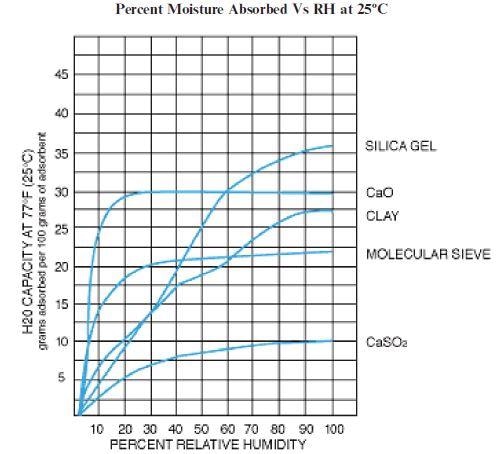Silica gel is the most common desiccant. It is a form of silica or silicon dioxide (SiO2); the same material that makes up quartz sand. Its ability to absorb moisture arises from the numerous small pores present in it, which form an extremely large surface area. It can hold up to 40% of its weight in moisture without any swelling. Hence, it can decrease the relative humidity (RH) in any closed container to less than 40% at any temperature over its operating range.
It can work from below freezing temperatures to above the boiling point of water, but its best performance is at room temperature (70–90 ºF/16–32 ºC) and high humidity (60–90%). Although above 100 ºF/38 ºC, its performance begins to decrease, it will still work until about 220 ºF/104 ºC. With a decrease in the RH, its ability to absorb moisture also decreases.
Bulk Desiccant (#19960 & #19961)
The bulk silica gel we have is an indicating type of silica gel. The moisture color indicator is due to bright blue crystals of a heavy metal salt, cobalt chloride. As the gel begins to absorb water, the color changes to light blue and finally pink, when it has absorbed about 8% of its weight in moisture. However, this is still well below its maximum absorption capability of 35–40%, which means it can still absorb more moisture. After it turns pink though, there is no way to tell by color when it has reached its full capacity. Then, it can be treated just like other non-indicating desiccants and weighed to determine the amount of water absorption. When the silica gel has absorbed its full capacity of about 40% of its weight in water, the cobalt chloride crystals will turn white because of supersaturation. At that time, it will need to be reactivated before it can be used again.
Reactivation can be done by heating the silica gel at 300 ºF/150 ºC in a convection oven for about three hours or until the crystals turn blue again. However, if the desiccant is packaged in Tyvek, it should not be heated to above 250 °F/121 °C to prevent damage to the material. The packets should be spread out so that they are not touching and should be placed at least 16 inches from the heating elements.
A microwave oven can also be used to dehydrate the silica gel. When using a 900 W oven, the crystals should be heated for 3-minute intervals until there is a change in the color. Ovens of different power will need different times. The process can be speeded up by spreading the dessicant in a microwave-safe pan in a thin layer. Heating the desiccant above 325 °F/149 °C or using a microwave of more than 900 W power can damage the gel and prevent it from absorbing any moisture. Microwave dehydration cannot be used on packaged desiccants e.g., DRICAP®, DriCan or Tyvek.
DRICAP® Capsule Dehydrators
DRICAP® Capsule Dehydrators (#19953 & #19956) are designed to be single use. However, they can be reused if the dehydrating temperature is high enough to remove moisture but not so high as to deform the plastic capsule. Desorption will not occur below 104 °C. A temperature of 110 °C in a convection oven in air for one hour has given good results. But, there can be some deformation, which can reduce the capability of the DRICAP® capsules by 5–10% per heating cycle.
The indicating silica gel is not food-safe and should be kept away from anything edible as cobalt is a heavy metal.
The reactivated desiccants should be stored in a sealed impermeable container. DRICAP® Capsule Dehydrators are packaged in a foil barrier bag that is resealable. They have a 1-year shelf life and a few capsules can be removed while keeping the performance of the rest intact as long as the bag is resealed properly.
DriCan Dehydrator (#19950) Cartridge Desiccant (#2240-3, #2244-3 & 2246-3) also contain indicating silica gel and can be recycled by heating in a convection oven at 300 ºF/150 ºC.

Figure 1

This information has been sourced, reviewed and adapted from materials provided by Ted Pella, Inc.
For more information on this source, please visit Ted Pella, Inc.